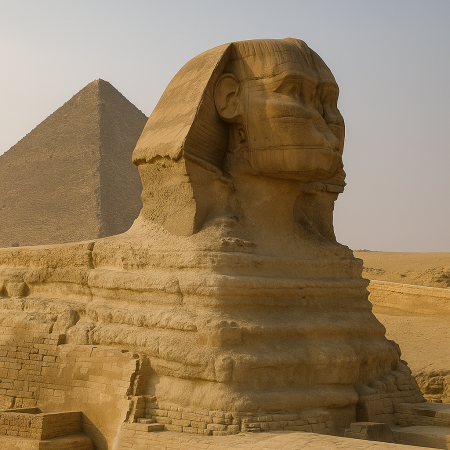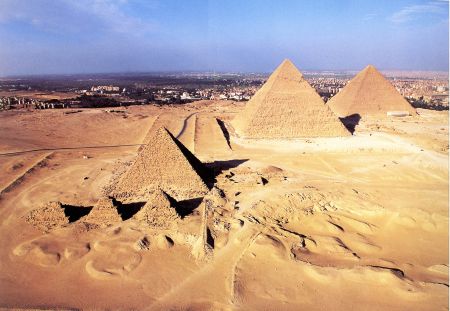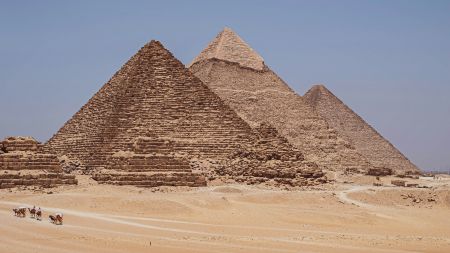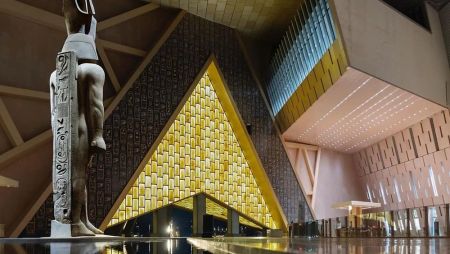The Secrets of The Valley Temple in Giza
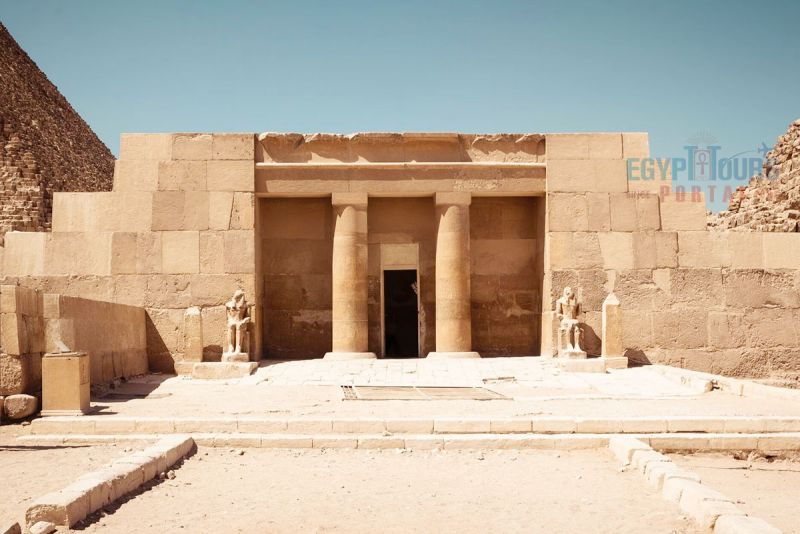
Introduction to the Valley Temple of Khafre – Gateway to Immortality
Tucked near the Great Sphinx of Giza and standing as a solemn witness to the glory of the Fourth Dynasty, the Valley Temple of Khafre is one of Egypt’s most enigmatic and best-preserved ancient structures. With its bold geometry, monolithic limestone blocks, and polished red granite interiors, this mortuary temple has survived thousands of years, whispering tales of pharaohs, divine rituals, and the mystery of life after death. Located on the eastern edge of the Giza Plateau, the Valley Temple is more than just a ceremonial building—it’s a vital component of the royal funerary complex that linked the Nile with the plateau’s pyramids.
The Valley Temple, also known as the Mortuary Valley Temple of Khafre, was constructed during the reign of Pharaoh Khafre (c. 2570 BC), builder of the second pyramid at Giza. This ancient marvel wasn’t simply a functional space—it played a spiritual and symbolic role in the ancient Egyptians’ belief system. Bodies of kings were received here from the Nile, purified, and ritually prepared for the afterlife. The temple connects to the pyramid complex via a causeway and faces directly toward the rising sun, emphasizing rebirth and eternal life.
More than just a passage to the great pyramid, the Valley Temple is a statement of permanence, religious devotion, and incredible engineering. With its elegant columns, T-shaped hall, and colossal statues that once stood inside, this sacred site continues to attract archaeologists, tourists, and spiritual seekers alike. The Valley Temple isn’t merely a remnant of the past—it’s a monument to Egypt’s obsession with eternity.
Historical Background of the Valley Temple
Constructed for Pharaoh Khafre – The Vision Behind the Valley Temple
Pharaoh Khafre, also known as Chephren, ruled during the Old Kingdom's Fourth Dynasty and commissioned one of the most ambitious architectural projects of ancient Egypt: his pyramid complex at Giza. The Valley Temple formed an integral part of this complex, working in tandem with the pyramid, the Great Sphinx, the causeway, and the mortuary temple.
Old Kingdom Engineering at Its Peak
The Valley Temple's construction reflects the ingenuity of Old Kingdom engineering. Massive limestone and granite blocks, some weighing over 100 tons, were precisely placed without mortar. These colossal stones were quarried nearby and transported using primitive tools, sledges, and manpower—a feat that continues to baffle modern architects and engineers.
Ritual Function and Sacred Purpose
Primarily, the Valley Temple served a ritualistic purpose. It acted as the transitional space between the mortal world and the eternal realm of the gods. The mummified body of Khafre would have arrived here by boat via a canal from the Nile, received the purification rites, and been prepared for entombment. The temple also housed statues of the pharaoh, allowing the spirit (ka) to receive offerings in perpetuity.
A Timeless Testimony of Royal Divinity
Over time, the Valley Temple became a symbol of divine kingship. Its seamless fusion of architecture, cosmology, and religion reinforced the belief that the pharaoh was both mortal and divine, a god in human form who would rise again with the sun each day.
Architectural Layout and Design of the Valley Temple
The Exterior Structure – Simple Yet Monumental
At first glance, the Valley Temple appears plain and austere. Its rectangular shape, constructed from heavy limestone blocks, lacks the decorative flair found in later temples. However, this simplicity belies its strength and intention. It was built to last forever—a visual metaphor for the eternal nature of the king’s soul.
The T-Shaped Hall – Heart of the Temple
Upon entering, visitors are greeted by a T-shaped hall flanked by 16 massive red granite pillars. This space was once lined with statues of Khafre, placed in niches along the walls. These statues, carved from diorite, granite, and alabaster, were positioned to gaze upon the offering tables, reinforcing the eternal relationship between the pharaoh and the gods.
Use of Materials – Red Granite, Limestone, and Alabaster
The Valley Temple employed a strategic combination of materials. White limestone blocks formed the core, while the inner walls were covered with gleaming polished red granite from Aswan. The floors were paved with alabaster, reflecting light into the otherwise dim space. These materials weren’t just decorative—they symbolized purity, strength, and divine essence.
The Statues of Khafre – Embodiments of Eternal Rule
Originally, 23 statues of Khafre stood within the Valley Temple. Although many have been lost or damaged, one famous diorite statue survives today and is housed in the Egyptian Museum in Cairo. It shows Khafre seated on a throne with the falcon god Horus protectively embracing his head—a powerful image that reinforced the pharaoh’s divine right to rule.
Location and Accessibility of the Valley Temple
Situated at the Foot of the Giza Plateau
The Valley Temple lies just southeast of the Great Pyramid of Khafre, near the paws of the Great Sphinx. It’s strategically placed at the junction between the Nile floodplain and the desert plateau, linking life and death, water and sand, the earthly and the divine.
Part of the Greater Giza Necropolis
As part of the Giza Necropolis, the Valley Temple complements other nearby monuments like the Great Pyramid, the Pyramid of Menkaure, the Sphinx Temple, and the workers' village. Together, they form a complete picture of life, labor, and legacy in ancient Egypt.
Visitor Experience and Current Condition
Today, visitors can explore the Valley Temple as part of the Giza complex tour. Although time has worn away many of its decorative features, the structure remains remarkably intact. Walking through its granite pillars, one can almost hear the chants of priests and smell the sacred incense that once filled the air.
Cultural Significance and Symbolism
Intersection of Life and Death
The Valley Temple embodied the ancient Egyptian worldview—a place where opposites met and transformed. The journey from the Nile (life) to the pyramid (afterlife) passed through this temple, making it a sacred liminal space.
Cosmic Alignment and Solar Symbolism
Aligned with celestial movements, the Valley Temple reflects the Egyptians’ advanced understanding of astronomy. The eastern orientation of the temple signified the sunrise and the daily rebirth of the soul, anchoring the pharaoh’s resurrection to the eternal cycle of the sun god Ra.
Eternal Legacy in Modern Culture
The Valley Temple continues to inspire architects, spiritual seekers, and travelers alike. It’s featured in documentaries, books, and historical analyses. Its mysterious aura and spiritual gravitas have made it a focal point for exploring ancient Egyptian metaphysics and sacred geometry.
Frequently Asked Questions about the Valley Temple
What was the purpose of the Valley Temple in ancient Egypt?
The Valley Temple was built to conduct purification and embalming rituals for Pharaoh Khafre before burial. It also served as a house of worship and a place to present offerings to the king’s spirit.
Where is the Valley Temple located?
The Valley Temple is located at the eastern edge of the Giza Plateau, adjacent to the Great Sphinx and near the Pyramid of Khafre.
Who built the Valley Temple?
The temple was constructed during the reign of Pharaoh Khafre, likely by skilled laborers, artisans, and overseers under royal direction during the Fourth Dynasty.
What materials were used in building the Valley Temple?
The core was made of local limestone, with interior walls covered in red granite and alabaster. Diorite statues were also part of the temple’s interior design.
Can visitors enter the Valley Temple today?
Yes, the Valley Temple is accessible to tourists as part of the Giza Plateau tour. It remains one of the best-preserved structures from ancient Egypt.


